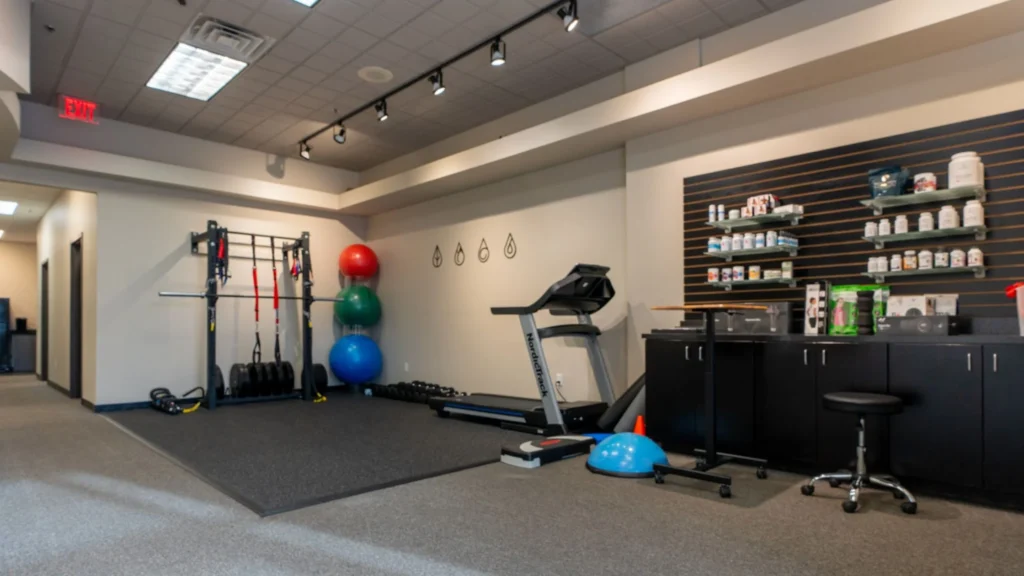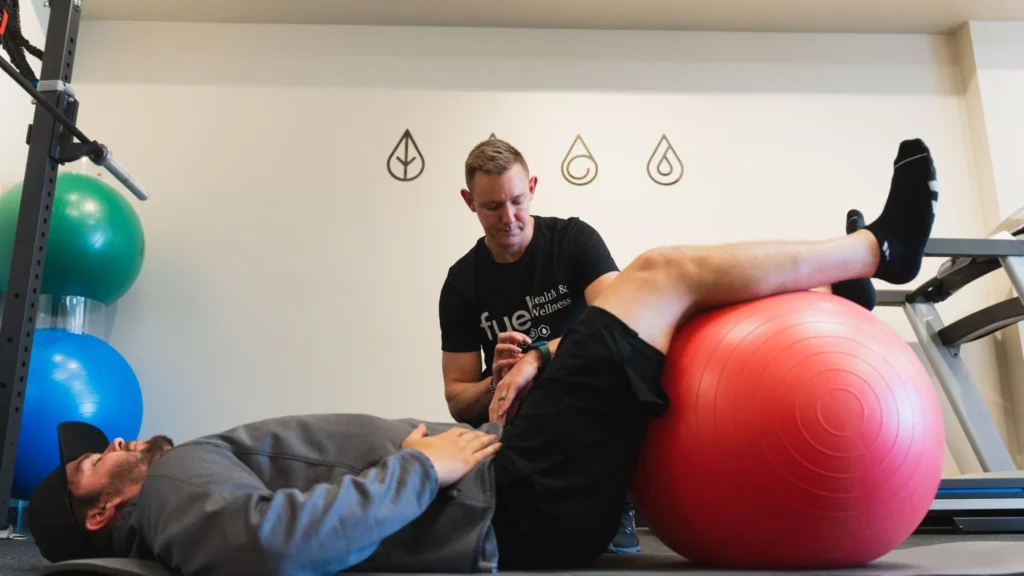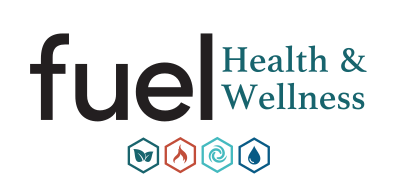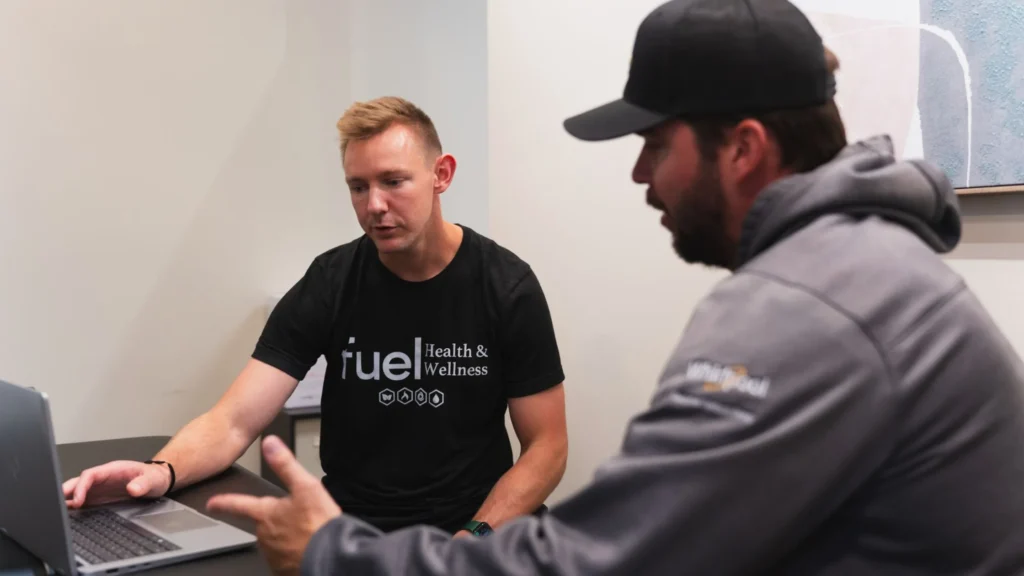Starting physical therapy can seem daunting, but understanding what to expect can empower patients to be proactive partners in their recovery. For individuals coming to Fuel Health & Wellness in Grandville, a trusted provider like fuel health & wellness ensures that the process is clear, supportive, and tailored to each patient’s specific needs. Physical therapy appointments are structured to provide thorough evaluations, personalized treatment plans, and education that help patients regain mobility, reduce pain, and improve overall health. This article is dedicated to guiding new patients through preparations, the assessment process, session routines, and ways to optimize long-term outcomes. By understanding what steps occur during an initial physical therapy session, patients can confidently approach their therapy journey and maximize the potential benefits of the treatment.
Key Takeaways
- Patients should prepare both their personal details and medical history for a comprehensive review.
- Essential items such as comfortable clothing, medications, and pertinent documents improve session efficiency.
- Understanding the treatment techniques and effective communication with therapists are crucial.
- Establishing a regular routine and committing to home-based exercises can enhance recovery.
- Maximizing outcomes involves attendance, feedback, and utilizing resources provided by the therapist.
Understand What to Expect During Your Initial Physical Therapy Session

Walking into your first physical therapy session at Fuel Health & Wellness in Grandville can be both an exciting and nerve-wracking experience. The initial session is designed to set the groundwork for a personalized treatment plan that suits the patient’s unique needs. Experts emphasize that preparation is key to making the most out of this session, ensuring that both the patient and the therapist have a full understanding of the case. The session begins with an in-depth review of the patient’s medical history, concerns, and previous therapies. This helps create an accurate baseline, allowing the therapist to design a treatment plan aimed at addressing pain points, mobility challenges, and overall functional goals.
Prepare Your Personal Information and Medical History
A crucial component of the initial assessment is the detailed discussion of personal information and medical history. Patients are encouraged to bring an updated list of current medications, previous diagnoses, and records of past injuries or surgeries. This documentation helps therapists consider factors like preexisting conditions such as knee injuries, back pain, or even issues related to the vestibular system that might affect balance. For example, if a patient has undergone knee replacement surgery or frequently experiences joint pain, mentioning these conditions up front enables the therapist to tailor every aspect of the session to meet these unique needs. Thorough documentation not only speeds up the assessment process but also minimizes the chance of overlooking significant health information.
Learn About the Assessment Process With Your Therapist
During the initial evaluation, the physical therapist will conduct a comprehensive assessment that includes a gait analysis and range of motion testing. This process helps to identify areas of weakness, tightness, or discomfort. The therapist might utilize various manual testing techniques to assess muscle strength, flexibility, and joint stability. In addition, specialized tests such as the McKenzie method for back pain or specific balance assessments might be performed, especially if the patient presents symptoms of vertigo or falls. This systematic evaluation is essential not only to diagnose the underlying problems but also to provide a clear picture that will shape the subsequent treatment plan.
Ask About Treatment Goals and Plan Options
Patients need to be proactive during their initial session by discussing treatment goals openly with their therapist. It’s important to clarify what specific improvements are being targeted, whether it’s reducing pain from a shoulder strain or regaining strength after an ankle injury. Asking questions about the therapy options available, such as manual therapy, exercise-based rehabilitation, or even integrated red light therapy, allows patients to make informed decisions. This conversation sets realistic short-term and long-term goals—for instance, achieving a 20% improvement in range of motion within a few sessions or reducing pain to a manageable level by the end of the treatment cycle. Understanding these goals helps in building trust and establishing a cooperative relationship between the patient and therapist.
Discuss Any Current Symptoms or Concerns You Have
Communication is pivotal during the evaluation process. Patients should be prepared to share any ongoing symptoms, including details regarding pain intensity, frequency, and occurrences that might be linked to daily activities. Discussing concerns such as residual pain after a previous treatment or new symptoms like muscle spasms or unusual joint sounds ensures that the therapist has a complete understanding of the patient’s condition. This safety net of awareness minimizes the risk of exacerbating an injury and allows for appropriate precautions and modifications in the treatment plan. For instance, if dizziness or vertigo is reported during mobility exercises, the therapist can adjust the session to incorporate balance-support techniques.
Confirm the Duration and Frequency of Your Sessions
Another essential step during the initial session is establishing the framework for continuing treatment. Patients should inquire about the expected duration of each session and how frequently appointments should be scheduled. This information helps in planning not just the therapy sessions but also coordinating with work, family obligations, and other life commitments. The therapist may recommend more frequent visits during the early stages, tapering off as improvements become noticeable. Clarifying this schedule early on gives the patient a realistic perspective of the commitment required to achieve optimal recovery and minimizes unexpected scheduling conflicts.
Clarify the Cost and Payment Information
Understanding the financial aspects of physical therapy Grandville is crucial for many patients. During the initial session, patients should ask detailed questions about session costs, accepted insurances, deductibles, available payment plans, and any potential out-of-pocket expenses. Transparency about cost is particularly important for those using Medicare or other health insurance programs. Discussing these details not only alleviates financial stress later but also ensures that patients are prepared to make the most of their recovery without worrying about unexpected bills. In many cases, clear communication about payment options contributes to a more trusting relationship between patient and provider.
Gather Essential Items for Your First Appointment

The effectiveness of your physical therapy session can be enhanced by bringing all the necessary items to your appointment. Preparation demonstrates commitment and allows the therapist to focus entirely on evaluating and addressing your needs. Gathering the required items before arriving minimizes delays and reduces stress on the day of the appointment.
Bring Comfortable Clothing for Movement During Therapy
Patients are advised to wear comfortable, loose-fitting clothing that allows for full range of movement during physical therapy exercises. Attire such as athletic wear or yoga pants, paired with a breathable top, ensures that patients can easily perform stretching and movement exercises without restriction. Ill-fitting or restrictive clothing can limit the effectiveness of assessments such as gait analysis or joint mobility tests. Additionally, comfortable clothing helps reduce self-consciousness, enabling patients to focus solely on their performance and progress during the session.
Pack Any Necessary Medications and Medical Equipment
If you rely on medications, braces, or other assistive devices, it is essential to bring them along to your session. Not only does this inclusion provide the therapist with important context regarding your treatment needs, but it also allows for modifications during exercises. For example, a patient managing chronic back pain might use a brace, or one with a history of vertigo may have motion sickness medicines. Bringing these items ensures that all relevant factors are considered during the evaluation and subsequent treatment planning. Moreover, having your own equipment can often provide comfort and continuity from previous treatments.
Include Insurance Information and Referral Documents
To streamline the administrative process, patients should carry their insurance cards and any referral documents from their primary care physicians or specialists. These documents are often critical for verifying coverage details and ensuring that the services provided are in line with patient benefits. Fuel Health & Wellness typically works with a broad range of insurances, including Medicare, so having these documents ready ensures that there are no delays in starting your treatment. It also prevents any misunderstandings regarding costs and covered services, thereby facilitating a smoother overall experience.
Consider Writing Down Questions You Want to Ask
A prepared list of questions can be incredibly useful during the initial appointment. The therapy session can be filled with information, and having pre-written questions ensures that your concerns are not forgotten. Questions might include inquiries about the specifics of treatment methods, expected timelines for improvement, or clarifications on any new symptoms you might have noticed. This planning shows the therapist that you are engaged in the process and are serious about your recovery. Moreover, it aids in making the session interactive, allowing both you and your therapist to set collaborative recovery goals.
Ensure You Have Water and Snacks for Post-Session
While it might not seem crucial, staying hydrated and having a light snack after your session can significantly influence recovery. Physical therapy sessions, especially those that involve endurance or strength training, can be physically demanding. Bringing a water bottle ensures that you remain hydrated during and after exercises. A nutritious snack can help restore blood sugar levels and provide the energy needed for recovery. This simple step can also set a positive tone for post-therapy routines such as guided stretches or relaxation techniques recommended by your therapist.
Prepare for Transportation Arrangements Beforehand
Logistical details such as transportation should also be organized ahead of time. Whether you plan to drive yourself or rely on a friend, family member, or public transport, ensuring that you have a reliable means of getting to and from your appointment is essential. Anxiety about transportation can detract from your focus and potentially disrupt your scheduled session time. Planning your route, checking traffic conditions, or arranging a ride well in advance minimizes stress and ensures that you arrive on time and ready to engage fully with your therapist. This is particularly important in busy areas like Grandville, where timely arrival can significantly affect the session schedule.
Familiarize Yourself With the Treatment Processes Offered
Understanding the variety of treatment options available during physical therapy can help patients set expectations and actively participate in their rehabilitation. At Fuel Health & Wellness, the treatment processes combine modern techniques with personalized care to address each patient’s unique condition. From manual therapy to exercise routines and educational resources, being knowledgeable about these processes creates a foundation for a successful recovery journey.
Understand Common Techniques Used in Physical Therapy
Physical therapy incorporates a range of techniques aimed at reducing pain, improving mobility, and enhancing overall function. Among these methods are manual therapy, therapeutic exercises, and modalities like ultrasound or electrical stimulation.
Manual therapy techniques, for instance, involve the therapist using their hands to mobilize soft tissue and joints, which can alleviate pain stemming from muscle strain or joint stiffness. This method is particularly beneficial for patients recovering from injuries such as shoulder strains or who suffer from chronic back pain. For those focusing on improving stability and preventing falls, Balance Improvement and Fall Prevention With Physical Therapy offers additional strategies to strengthen mobility and reduce the risk of injury.
Other techniques, like therapeutic exercises, are designed to strengthen muscles, improve flexibility, and support natural wound healing processes. These exercises are often customized to each patient based on the initial assessment and are pivotal in enabling long-term self-sufficiency post-recovery.
Learn About Manual Therapy and Its Benefits
Manual therapy involves a series of hands-on techniques used by the therapist to target musculoskeletal pain and dysfunction. This can include joint mobilization, soft tissue manipulation, and stretching techniques that contribute to increased blood flow and enhanced tissue elasticity. Patients with conditions such as knee pain or a history of joint injuries often find manual therapy provides instant relief. Scientific studies have shown that regular manual therapy can decrease pain levels by a significant percentage while improving range of motion—a key metric when tracking recovery progress. Discussing these techniques with your therapist will provide insight into how these methods can be tailored to address personal symptoms and improve overall biomechanical function.
Know About Exercise Programs Tailored for Your Needs
A critical element of most physical therapy programs is the design and execution of tailored exercise regimens. These exercise programs are not only focused on immediate pain relief but also on long-term recovery and strength building. The therapy team collaborates with patients to establish routines that target specific areas of weakness or imbalance. For example, a person recovering from a hip injury may be assigned exercises that focus on hip stability and leg strength through dynamic stretches and resistance training. These exercise programs are often accompanied by progressive modifications to ensure that as the patient’s strength and endurance improve, so too does the challenge of the routines. Personalized exercise plans are reinforced with educational materials that demonstrate proper technique, which is critical for avoiding further strain and maximizing therapeutic benefits.
Explore Educational Resources Provided During Therapy
In addition to active treatments, education is a cornerstone of effective physical therapy. Patients are provided with a variety of resources that explain the underlying causes of their symptoms, the anatomy involved, and the best practices for maintaining improvements between sessions. These educational resources can include printed materials, video demonstrations, or even digital platforms with interactive guides. By understanding the principles behind their recovery process—such as the importance of proper gait analysis or the benefits of manual tissue therapy—patients are empowered to extend the benefits of their therapy beyond the clinical setting. This knowledge also contributes to better adherence to home exercise programs and improved overall recovery outcomes.
Recognize the Importance of Home Exercise Routines
Home exercise routines form a vital part of physical therapy, ensuring that progress achieved during in-office sessions is not lost. Adherence to these routines can significantly reduce pain and accelerate improvements in mobility. Patients are often given detailed instructions, including pictures and step-by-step guidance, to help them perform exercises correctly at home. The consistency of these daily or weekly exercises reinforces the work done in the clinic and is particularly important for maintaining strength and flexibility. Feedback provided during subsequent sessions helps to gradually adjust these routines, ensuring they remain effective over time. By taking ownership of their rehabilitation through commitment to home exercises, patients can achieve lasting improvements in joint pain, muscle strength, and overall functional ability.
Investigate Options for Different Levels of Care
Physical therapy is not a one-size-fits-all solution; rather, it offers multiple levels of care to match the severity and nature of a patient’s condition. Some individuals may benefit from a basic therapeutic exercise program, while others might require more intensive treatments involving manual therapy and specialized modalities such as gait correction for balance issues. Additionally, some patients, particularly those recovering from major surgeries like knee replacement, might require long-term rehabilitation support involving periodic check-ups and extensive therapeutic exercises. Understanding and discussing these options with your therapist enables a more accurate alignment of treatment intensity with patient needs. This approach ensures that each person receives a customized care plan aimed at promoting steady improvement and functional independence.
Communicate Effectively With Your Physical Therapist

Effective communication with your physical therapist is fundamental to maximizing the benefits of each appointment. Open dialogue helps to fine-tune the treatment plan, ensuring that your specific needs, pain levels, and progress are consistently monitored. This collaborative approach is essential for adjusting the therapy program as needed and addressing any new concerns that might arise during the recovery process.
Be Open About Your Pain Levels and Limitations
Patients are encouraged to honestly communicate any discomfort, pain, or limitations they experience—whether these are related to everyday activities or exacerbated by specific movements during the session. Providing detailed feedback about pain levels, such as the intensity on a scale of 1 to 10 or specific triggers that cause strain in areas like the ankle or back, enables the therapist to adapt the treatment plan accordingly. For instance, if a patient experiences increased pain during certain stretches, these can be modified or replaced with less strenuous alternatives. Detailed communication helps in avoiding further injury and ensures that recovery protocols are safe and effective. This openness also leads to more precise adjustments in techniques like manual therapy or adjustments in exercise routines, supporting overall progress.
Ask for Clarifications on Any Procedures or Techniques
It is essential for patients to ask questions if they are unsure about any aspect of the treatment plan or the techniques being used. Inquiring about how specific exercises benefit muscle strengthening, why certain modalities like electrical stimulation are being recommended, or how a particular method can improve joint movement fosters a deeper understanding of the therapy process. By gaining clarity on these procedures, patients become active participants in their rehabilitation. This clarifies expectations and minimizes misconceptions that could hinder recovery. A well-informed patient is better able to adhere to home exercise programs and understand the rationale behind each component of their treatment plan. Active engagement and questioning are thus central to a successful therapy outcome.
Discuss Any Previous Therapy Experience or Outcomes
Sharing past experiences with different therapy approaches can provide valuable insights to your current therapist. Whether previous sessions resulted in positive improvements or highlighted specific challenges, this discussion helps the therapist in designing a more effective treatment plan. If a patient has tried certain exercises with little success or experienced unfavorable outcomes from previous treatments, sharing this information facilitates a more personalized approach. For example, if manual therapy did not yield the desired improvements during past sessions, your therapist may explore alternative techniques or adjust the intensity of treatment. Open discussion regarding prior experiences ensures that repetitive mistakes are avoided and that the new treatment plan is better aligned with proven methods that suit the patient’s lifestyle and needs.
Provide Feedback on Your Comfort During Sessions
Comfort is a critical factor in the success of any physical therapy session. Patients should feel confident in voicing their comfort levels throughout the session. Whether it is adjusting the temperature in the room, the cushioning of the treatment table, or the pace at which exercises are conducted, feedback helps the therapist create a conducive healing environment. This feedback may also include practical suggestions, such as modifying the exercise routine if too strenuous or increasing time for rest and recovery. The goal is to create a session that is both challenging enough to stimulate improvement and comfortable enough to prevent additional strain or injury. A consistent feedback loop supports continuous improvements in the therapy process, ensuring that every session is as efficient and effective as possible.
Share Your Goals for Recovery With Your Therapist
Communicating your recovery goals is vital for setting a clear direction for your treatment plan. Patients should openly share both short-term and long-term objectives—whether it’s alleviating chronic pain, enhancing flexibility, or returning to a preferred sport or activity. Discussion of these goals allows the therapist to design a program that is both measurable and achievable. It also sets a timeline for expected improvements, which can be motivating and provide a sense of progress. Clear goals help in monitoring progress over time and adjusting strategies when certain milestones are not met. This goal-oriented communication establishes a partnership between the patient and therapist, ensuring that each session drives the overall recovery process forward.
Stay Engaged in the Therapeutic Process
Active participation in every session is crucial for optimal outcomes. Patients are encouraged to engage in discussions, ask follow-up questions, and provide regular updates on any changes they experience between visits. This engagement ensures that the therapy plan remains dynamic and responsive to ongoing improvements or setbacks. By staying mentally and emotionally involved in the process, patients can help identify early signs of improvement or notice if adjustments are necessary. Consistent engagement reinforces the commitment required for long-term recovery and helps create a trusting relationship with the therapist, which is a cornerstone for achieving successful results.
Establish a Comfortable Routine for Ongoing Sessions

Creating and adhering to a consistent schedule is critical for long-term recovery in physical therapy. Establishing a routine not only helps in making gradual progress but also fosters a sense of discipline and structure necessary for healing and performance improvement.
At Fuel Health & Wellness, patients are encouraged to treat physical therapy as an integral part of their lifestyle. Those seeking convenient access to rehabilitation services may find Telehealth Physical Therapy Services From Home in Grand Rapids particularly helpful in maintaining consistency and ensuring effective recovery.
This approach is not only beneficial for physical recovery but also for building a baseline for future health, particularly in managing chronic conditions and preventing injuries.
Plan Your Schedule for Regular Appointments
Patients are advised to work with their therapist to create a regular appointment schedule that complements their daily routines. This could mean setting up sessions during times when energy levels are typically higher or strategically planning appointments around work and family commitments. A consistent schedule helps in developing a routine that reinforces the therapeutic benefits of each session. Paying attention to the frequency and duration of these appointments is important; increasing the frequency of sessions during the early stages of recovery often yields faster improvements. Regular appointments also create opportunities for periodic re-evaluations, ensuring that the treatment plan is continuously adjusted to reflect progress and changing needs.
Set Short-Term and Long-Term Goals With Your Therapist
A crucial part of establishing an effective routine is collaborating on clear, realistic goals for both the short and long term. Short-term goals might include achieving a specific range of motion or reducing pain levels after a few sessions, while long-term goals could target overall improvements in mobility and return to normal functional activities. These goals serve as benchmarks to gauge success and help maintain motivation throughout the recovery process. The therapist can use detailed assessments and data, such as improvements in gait or increased range of motion, to validate progress. This goal setting not only boosts confidence but also helps in tailoring future sessions to address areas where improvement is still needed.
Monitor Your Progress and Celebrate Milestones
Tracking progress is an integral aspect of physical therapy, serving as both a motivational tool and a guide for future treatment adjustments. Patients should be encouraged to keep a detailed log of pain levels, mobility improvements, and other relevant metrics throughout their therapy journey. This may include simple notes on better sleep after manual therapy sessions or a noticeable increase in strength after engaging in targeted exercise routines. Celebrating even small milestones creates a positive feedback loop that reinforces the patient’s commitment to their recovery program. Tools such as progress charts, before-and-after assessments, and periodic evaluations can provide quantifiable evidence of improvement, helping to validate the effectiveness of the treatment plan.
Adapt Your Routine Based on Feedback From Your Therapist
Flexibility is essential in any ongoing therapy regimen. As patients progress through their treatment, regular feedback from the therapist helps determine whether the established routine continues to be effective or needs modification. For instance, if exercises that once challenged a patient’s strength begin to feel too easy, the therapist may introduce modified versions or add additional repetitions to maintain a beneficial level of stimulus. Conversely, if certain exercises become too strenuous and lead to pain, adjustments can be made to find a more comfortable alternative. This adaptive approach ensures that the treatment remains aligned with the patient’s current condition and recovery objectives, preventing plateaus and encouraging continuous progress.
Maintain Communication Between Sessions for Better Care
Effective long-term recovery is greatly enhanced by maintaining open lines of communication between sessions. Patients should be encouraged to send updates through email or patient portals if they experience any unexpected changes in pain, mobility, or overall health. This ongoing dialogue allows the therapist to provide timely advice and make necessary adjustments to home exercise routines. Moreover, being reachable between sessions shows a commitment to the recovery process and fosters a relationship built on trust. By staying connected, patients not only reinforce their commitment to therapy but also enable early intervention if any challenges arise, ensuring that setbacks are minimized and progress remains steady.
Seek Support From Family or Friends if Needed
The journey toward recovery is not one that must be undertaken alone. Patients are encouraged to seek emotional and logistical support from family members or friends. Whether it’s a ride to and from appointments or simply having someone to share the challenges and successes with, the involvement of loved ones can make a significant difference. Support networks provide encouragement during difficult times and reinforce positive behaviors that contribute to faster recovery. For many, having a support system helps manage stress, which is often a contributing factor to the persistence of pain and injury. This communal approach to recovery not only uplifts the patient’s morale but also anchors the therapy process in a comprehensive, well-rounded support system.
Know How to Maximize Your Outcomes in Physical Therapy
Maximizing the benefits of physical therapy requires commitment, consistency, and a proactive approach toward all aspects of the treatment process. Fuel Health & Wellness emphasizes that outcomes are significantly enhanced when patients actively participate in their recovery, both during sessions and at home. By following strategic guidelines and leveraging all available resources, patients can empower themselves to achieve lasting improvements in their health and overall quality of life.
Commit to Attending All Scheduled Appointments
One of the most important ways to improve therapy outcomes is to attend every scheduled appointment. Consistency plays a vital role in building the momentum needed for recovery. Missing sessions not only disrupts progress but can also slow down the rate of improvement in areas like muscle strength and joint mobility. When sessions are consistently attended, each appointment builds upon the previous one, creating a cumulative effect that can lead to significant and measurable improvements over time. This is particularly relevant for patients undergoing rehabilitation for conditions such as injury recovery, chronic pain, or post-surgical rehabilitation. By fully committing to the scheduled sessions, patients support a continuous, gradual improvement that translates into better long-term results.
Perform Recommended Exercises at Home Consistently
In addition to attending therapy sessions, patients must commit to a robust home exercise program. The exercises prescribed by the therapist are essential for fostering improvements achieved during in-office sessions. Regular performance of these exercises helps maintain muscle strength, flexibility, and overall functional mobility. For instance, a patient working on improving range of motion in the shoulder must perform specific stretches and strengthening exercises daily to see lasting benefits. Consistency in home exercises provides ongoing stimulus to the muscles and joints, reinforcing the work done during sessions and preventing regression. Home exercise routines should be viewed as an integral component of the therapy process—one that bridges the gap between professional treatment and everyday recovery.
Stay Positive and Focused Throughout Your Recovery
A positive mindset is an underrated yet essential component of successful physical therapy. Research indicates that patients who maintain a hopeful and focused attitude tend to experience faster recovery when compared to those who are pessimistic. Staying positive can involve a range of strategies, such as setting realistic goals, celebrating incremental improvements, and practicing mindfulness during exercises. A strong mental attitude encourages adherence to both therapy sessions and home routines, making it easier to overcome temporary setbacks. With clear communication and support from both the therapist and a patient’s personal network, maintaining a positive outlook reinforces the belief that recovery is achievable, thereby enhancing overall outcomes.
Utilize Resources Offered by Your Therapist
Fuel Health & Wellness offers a variety of resources to supplement in-office therapy sessions. These resources may include instructional videos, printable exercise guides, progress charts, and even mobile apps designed to track recovery. Utilizing these supplementary tools can deepen a patient’s understanding of their condition and improve compliance with assigned exercises. These materials are specifically curated to reinforce the techniques demonstrated during sessions, ensuring that patients perform exercises correctly and with optimal benefit. Taking full advantage of these tools not only fosters better technique but also encourages knowledge retention, ultimately leading to a more effective recovery process.
Keep Track of Your Progress and Adjust Goals
Monitoring progress regularly is crucial to keeping your recovery on track. Patients are encouraged to use journals or digital tools to log pain levels, exercise performance, and functional improvements. These records serve as a tangible measure of progress over time and help identify areas needing further intervention. Regularly reviewing these notes with your therapist allows for swift adjustments to the treatment plan—if certain exercises are underperforming, modifications can be made for a more targeted approach. This proactive strategy of tracking and adjusting ensures that the recovery process remains dynamic, continually pushing forward in a structured manner that is responsive to emerging needs.
Learn About Follow-Up Treatments or Additional Therapies
The journey to full recovery may involve several phases, and understanding subsequent treatment options is key to long-term success. After initial improvements, follow-up treatments such as maintenance sessions or advanced rehabilitation therapies may be recommended. These sessions help consolidate gains made during the initial phase and prepare the patient for a gradual return to full physical activity. Whether it involves periodic check-ins for gait analysis, manual therapy refinements, or specialized interventions for pain management, being open to additional therapies ensures comprehensive care. Patients should discuss these possibilities upfront so that, as their condition improves, there is a clear roadmap for sustaining and building on each milestone reached. For any questions or further guidance, please contact us.
Frequently Asked Questions
How should I prepare for my first physical therapy session?
To prepare, compile your medical history and personal information, wear comfortable clothing, and bring any necessary medications, insurance details, and referral documents. Writing down questions beforehand can enhance your session as well.
What techniques are commonly used during the initial assessment?
The initial assessment typically includes a detailed review of your medical history, manual therapy techniques, range of motion tests, and sometimes gait analysis. These procedures help the therapist develop a tailored treatment plan based on your physical limitations and goals.
Why is it important to maintain a regular appointment schedule?
Consistent attendance ensures continuous progress in recovery and helps the therapist monitor improvements accurately. Regular sessions allow for timely adjustments to your treatment plan, increasing the chances of effective pain management and enhanced mobility.
How do home exercise routines influence physical therapy outcomes?
Home exercises reinforce the progress made during in-office sessions. Consistent practice helps in building and maintaining muscle strength, enhancing flexibility, and preventing setbacks, which are critical for long-term recovery and improved functionality.
What can I do if I experience discomfort during therapy sessions?
It is important to communicate openly with your therapist about any discomfort or pain. Providing detailed feedback allows the therapist to adjust techniques or modify exercises to ensure a safe and effective treatment, ultimately enhancing your recovery process.


